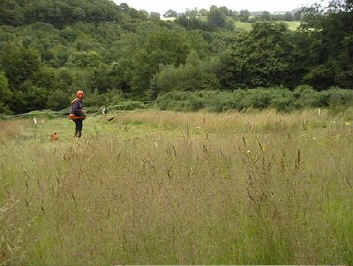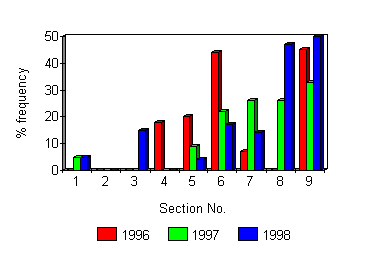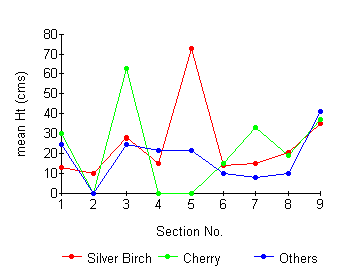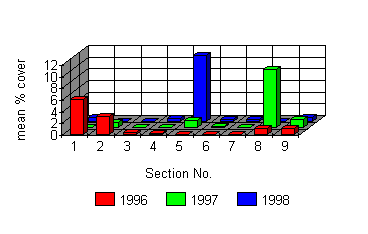|
The
Woodland Education Centre |
|
|
The
Woodland Education Centre |
|
Ecological Surveys 1996 - 1998
The Effects of Management -
Brushcutting on Tree Seedlings.
 |
The most common tree seedlings on the
site were Silver Birch (Betula pendula) and a non-native Cherry (Prunus sp.). Brushcutting
controlled their height, but not their distribution on the site. These two species
appeared to be in direct competition. Silver Birch was much more abundant, but the cherry grew more rapidly after cutting. Tree species were becoming dominant in the control section and in time will shade out the shorter vegetation. The only other area of the site where they were likely to be a problem was section 9 which is uncut. The management regime in this section is hand weeding, so they can be controlled in this way when resources allow. |
Tree Seedlings The growth of trees on heathland sites is one of the major obstacles to maintaining heath vegetation and associated fauna. Tree seedlings, particularly Silver Birch and Pine, readily colonize heath areas. Unless their growth is checked by fire, cutting or grazing, they rapidly grow tall, shading out the underlying heath vegetation, which is unable to compete. Succession from heathland to woodland is the natural consequence. Silver Birch (Betula pendula) and Cherry (Prunus sp.) were the major tree species colonizing the project site. Sycamore (Acer pseudoplanatus) seedlings were common on the site in 1996, but had disappeared by 1998. Other tree species colonizing the area included Holly (Ilex aquifolium), Rowan (Sorbus aucuparia), Oak (Quercus sp.), Ash (Fraxinus excelsior), Willow (Salix spp.) and rhododendron (Rhododendron ponticum). Rhododendron was present in sections 1,5 and 9 by 1998. Silver Birch was distributed over the whole site (Figures below), but was most abundant in sections 5 and 9. Neither of these sections have been cut, which allowed the Silver Birch to grow freely. Section 5 is the control section and will not be touched. However, section 9 is managed by hand weeding and this will be used to control the birch in this area. |
| Cherry seedlings were mainly found in the northern areas of the project site (Figures below). This is because the original source of the seedlings was cherry trees in the woodland bordering section 9. The cherry was gradually spreading to the southern regions of the project site and had extended into section 1 by 1998. The cherry trees in the bordering woodland are non-native and have since been removed to help control the spread of the seedlings. |
 |
 |
Mean % cover of Cherry 1996 - 1998. |
% frequency of Cherry 1996 - 1998. |
| The height of the Silver Birch was greatest in section 5. Its height in section 9, the other uncut area was less than half that in the control (Figure below). This is possibly due to competition with cherry which was most abundant in this area. Cherry often reached greater heights than birch in the areas which are cut (Figure below). It must therefore regenerate more quickly and may have a competitive edge in the areas which are brushcut. |
 |
Tree seedling heights 1996 - 1998 |
| Other
tree species had a significant presence only in the control section by 1998 ( Figure
below). Initially, they were most abundant in the sections (1,2 8,9) bordering on the
neighbouring woodland because this is the source of the tree seedlings. By 1998, they had a very low % cover in all sections but the control section as a result of brush cutting. |
 |
Distribution of minor tree species 1996 - 1998 |
Continue to the
indirect effects of brushcutting ![]()
Ecological Surveys 96 - 98 |